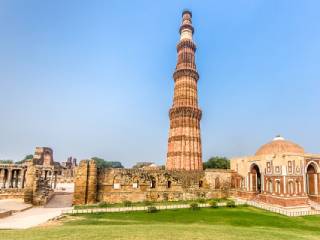
Former Archaeological Survey of India (ASI) Regional Director Dharamveer Sharma has said that Qutub Minar was actually Surya Stambh. He claimed it was not built by the Mughals but by Emperor Vikramaditya. He further said that the structure was not built in parts as the historians suggest.
Sharma said the tower was an observatory to count constellations. There are 27 binocular locations in the Minaret to calculate 27 constellations. He further claimed that on the third floor of the Minaret, there is a mention of Surya Stambh.
Dharamveer Sharma is one of the most respected archaeologists in India. He has served as Superintending Archaeologist in the Delhi division of ASI three times. As per a report in Hindi daily Jagran, he had worked extensively on the conservation of Qutub Minar and went inside the Minaret multiple times. He said he had seen Devanagari writing in the inner parts of the minaret. Every year on June 21, he takes astronomers to the complex.
Sharma said that based on the archaeological evidence, Qutub Minar used to be a large observatory, and it was built by Emporer Vikramaditya. He presented a 20-point fact sheet to prove his theory that Qutub Minar was an observatory.
- The construction of the Minar is based on astronomy.
- The Minar was built above the Tropic of Cancer.
- It was constructed to calculate the activity of the sun.
- At 12 PM on June 21, the shadow of the tower did not fall on the ground.
- It is five degrees north of the Tropic of Cancer.
- Emperor Vikramaditya built it on Vishnupad hill and it was named Surya Stambh.
- There were bells, climbers etc., made on the Minaret that point toward Hindu architecture.
- Not even a single name of a Muslim appeared on the Minaret constructed.
- It was built under the leadership of astronomer Varaha Mihir.
- There is no roof on the observatory.
- The main gate of the observatory opens in the direction of the pole star.
- Till the year 968, there used to be a stone in front of the main gate of Qutub Minar. It was cut in a U shape. If someone placed his/her chin on the stone, he/she would see a pole star in front.
- There are 27 niches in the Minaret. In those niches, words like Pal and Ghati are written in Devanagari.
- The niches have holes that would fit binoculars. Every niche can accommodate three people.
- Several inscriptions inside Minaret are written in Devanagari, dating back to the seventh and eighth centuries.
- Leaving the main gate, all the gates of the Minaret open towards the east, making it easier to observe the rising sun.
- If someone shouts inside Minaret, the sound will not go out. Thus, it cannot be used to give Azaan.
- The Minaret was built in one go, contrary to the Historians’ claims that it was built by several Mughal rulers.
- Farsi can be found only on the outer side of the Minaret.
- There used to be 27 constellation temples around the Minaret. They were demolished by the Mughals.
NMA asked to move Hindu idols from the Qutub Minar complex
Recently, it was reported that the National Monuments Authority (NMA) has asked the Archaeological Survey of India (ASI) to retrieve two Ganesha idols placed in the Qutub Minar complex. The NMA chairman wrote to ASI late last month, requesting that the two Ganesh idols called, Ulta Ganesh and Ganesha in the cage, be removed from the Qutub Minar complex and relocated to the National Museum. He believed that the “placement of the idols is disrespectful,” and that it should be changed.
Court rejected a plea to restore temples destroyed to build Qutub Minar Complex
In December 2021, a Delhi Court rejected a plea to restore 27 temples destroyed to build Qutub Minar Complex. The court accepted that the temples were destroyed, however, the court had refused to admit the petition because it was scared of “disturbing peace”.
Source : OpIndia




